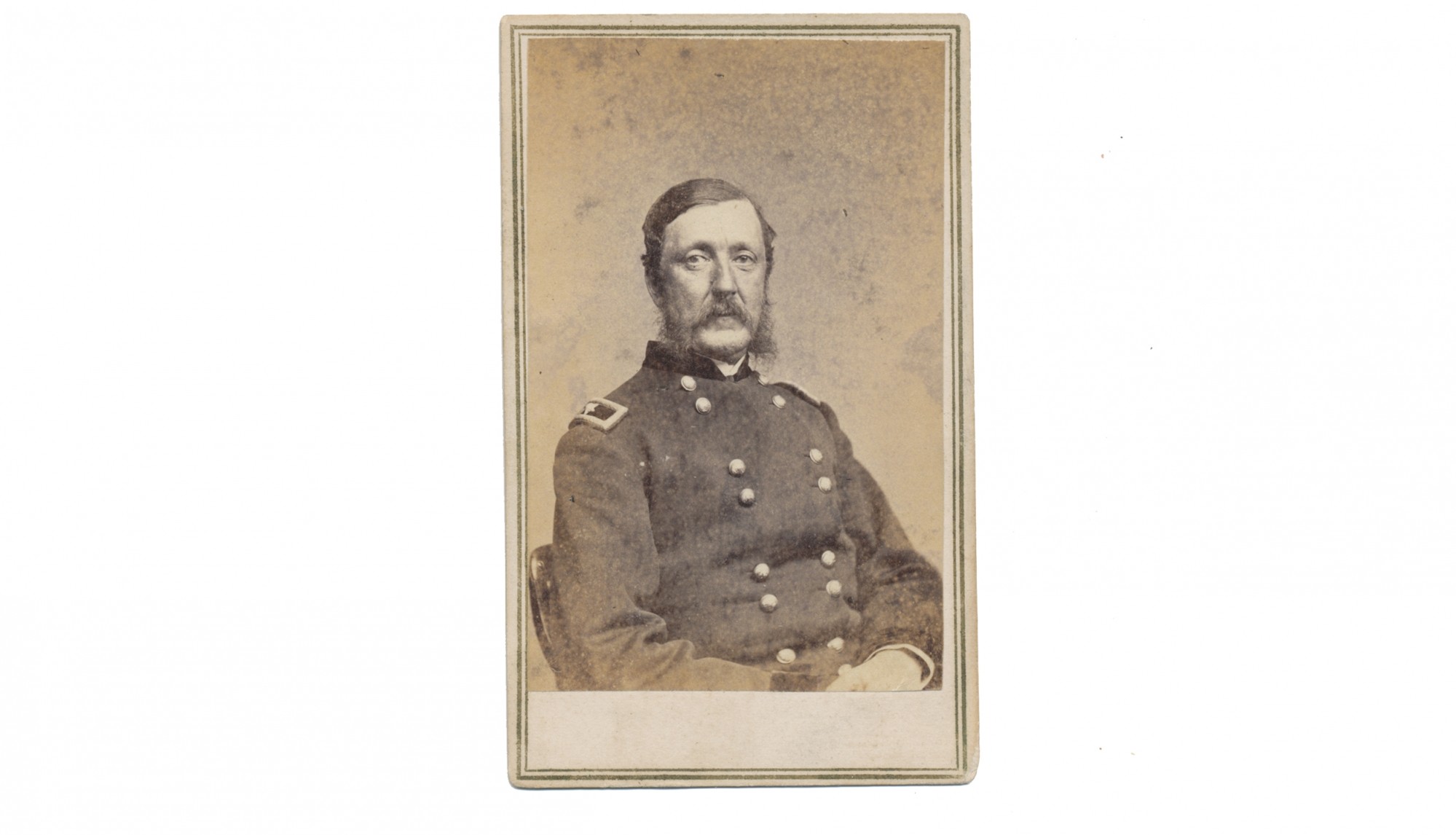site search
online catalog
CDV THREE-QUARTER SEATED VIEW OF BRIGADIER GENERAL WILLIAM F. BARRY

$165.00 SOLD
Quantity Available: None
Item Code: P13700
Image shows Barry wearing a dark double-breasted frock coat with Brigadier General shoulder straps. Image is grainy but clear with good detail.
Reverse has a photographer’s imprint for E. & H. T. ANTHONY FROM A BRADY NEGATIVE. Period inscription at top reads “MAJ GEN BARRY.”
William Farquhar Barry was born in New York City August 8, 1818. He graduated from the United States Military Academy in 1838, 17th in his class of 45 cadets. He was commissioned a brevet second lieutenant in the 4th U.S. Artillery, transferring to the 2nd U.S. Artillery a few weeks later. He was stationed near the Canada–US border, then later took part in the Mexican, Seminole, and the Kansas-Missouri Border Wars.
He was the co-author of Instruction for Field Artillery (1860), along with William H. French and Henry J. Hunt.
Promoted to major of artillery shortly after the start of hostilities between the Union and the Confederacy, Barry served as Brig. Gen. Irvin McDowell's chief of artillery during the First Battle of Bull Run, where his position was overrun after mistaking advancing Confederates for retreating Union forces. Barry was appointed brigadier general by President Abraham Lincoln on August 20, 1861. Barry is also credited with the concept that became the U.S. Horse Artillery Brigade in the Army of the Potomac.
As chief of artillery under Maj. Gen. George B. McClellan, Barry organized ordnance for the Army of the Potomac and, during the Peninsula Campaign, took part in the battles of Yorktown, Mechanicsville, Gaines' Mill, White Oak Swamp, and Malvern Hill.
After supervising forts and ordnance surrounding Washington, D.C., Barry became chief of artillery under Maj. Gen. William T. Sherman, serving with him in Tennessee, the March to the Sea, and the Carolinas Campaign. On January 23, 1865, President Lincoln nominated Barry for appointment to the brevet grade of major general of volunteers, to rank from September 1, 1864, for his service in the Atlanta Campaign. Barry was mustered out of the volunteer force on January 15, 1866. On July 17, 1866, President Andrew Johnson nominated Barry for appointment to the brevet grade of major general in the Regular Army, to rank from March 13, 1865.
On December 11, 1865, Barry was appointed colonel in the 2nd U.S. Artillery, and was in command of the northern frontier during the Fenian raids of 1866. He served there until September 1867, and then commanded the artillery school of practice at Fort Monroe until March 1877, when he was appointed to the command at Fort McHenry, Baltimore, Maryland. During the labor riots of 1877 he rendered valuable service at Camden Station.
Barry died at Fort McHenry and is buried at Forest Lawn Cemetery in Buffalo, New York. [ad]
~~~~~~~~~~~~~~~~~~~~~~~~~~~~~~~~~~~
THIS ITEM, AS WITH ALL OTHER ITEMS AVAILABLE ON OUR WEB SITE,
MAY BE PURCHASED THROUGH OUR LAYAWAY PROGRAM.
FOR OUR POLICIES AND TERMS,
CLICK ON ‘CONTACT US’ AT THE TOP OF ANY PAGE ON THE SITE,
THEN ON ‘LAYAWAY POLICY’.
Inquire About CDV THREE-QUARTER SEATED VIEW OF BRIGADIER GENERAL WILLIAM F. BARRY
For inquiries, please email us at [email protected]
Most Popular
Historical Firearms Stolen From The National Civil War Museum In Harrisburg, Pa »
Theft From Gravesite Of Gen. John Reynolds »
Cavalry Carbine Sling Swivel »
Fine Condition Brass Infantry Bugle Insignia »
featured item
CONFEDERATE GENERAL LUNSFORD LINDSAY LOMAX AS A WEST POINT CADET IN DAGUERREOTYPE BY ANSON CA. 1854/55, EX-BILL TURNER COLLECTION
Formerly in the collection of Virginia collector and dealer Bill Turner this ninth plate cased daguerreotype by Rufus Anson of New York City is extremely clear, nicely cased, has a mat showing the photographer’s name and address, and shows later… (1138-1905). Learn More »




